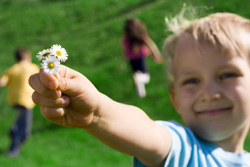
Giving is an emotional response. Children are much more emotional than rational compared to their parents. People touch their hearts, whether in person, on television or through the Internet. They have more money, even at a young age, than most parents and grandparents ever had in childhood. They can give more than ever. But they need to be informed and trained to make a difference in the lives of others and in meeting needs.
“So often, children are afraid of what’s happening in the world around them—and giving can help them deal with it,” says consultant and trainer Carol Weisman, author of the book, Raising Charitable Children. “Children fear that what’s happening in the news will happen to them—and that frightens them.” Weisman says that religious teachings can stir children to give—but can also misguide them and cause them to become bothered and frightened. “Philanthropy, however, gives a sense of empowerment. When you give, you are changing the world and helping step by step. You can change the world in two ways: pray and do. And that brings peace.”
Like so many life disciplines, there is a seed of stewardship in children. They have not become so busy or too cynical about life to turn the other way when there is suffering and need. They want to do something concrete and direct to help. They will take leadership from adults—but they want to know that they can do something as children. They will help clean up a mess, try to do something to make a suffering person find some joy and save and collect money to help.
American children want to help children in dire need all over the world with money, but also in very tangible ways, with school supplies and books. Third World children often have no materials, books or even a school. That’s hard for American children to comprehend, and learning about such needs in other parts of the world motivates giving. When Hurricane Katrina devastated New Orleans and nearby Gulf Coast areas, children responded with energy and urgency—by raising money, by helping children with clothing, food and water and helping supply library books and school supplies. The contributions were costly—but to the young donors, the satisfaction of helping was worth it. It’s all very practical.
Weisman sees many opportunities for shared stewardship in financial giving, volunteering and even in opportunities for children to lead adults in stewardship. “One of the great lessons of giving is to ask, ‘What would make giving to an organization a happy experience? What’s joyful?’ It’s important to explain all that a helping group does, and the many varieties of care and relief for others.” Mission trips to other cultures and places can help children find an outlet for giving, sharing and learning, including family members, their friends and the people whom they are serving.
By 18 years of age, a young person’s cluster of values, habits and practices have become permanent. Giving patterns are welldefined, whether with church, nonprofits or through group activities in college, the workplace or church. Stewardship begins in childhood and becomes deeply rooted as pastors, parents, mentors and leaders stress the importance of generous giving—and witness to it in their own giving.
In the end, topics about money are best handled as family matters—and these discussions do not occur very often. When parents and children talk about money, they revolve most often around spending, then about earning—and rarely about giving. Parents handle the topic best in exactly the reverse order. With guidance, a child can show adults how to live out the priorities of help and care—and at the top of the list is generous and gracious giving as stewards of the world in which we live. TPW
Dr. John Throop is the president of The Summit Planning Group, a Peoria-based nonprofit and public agency consulting and training firm that has served over 120 organizations throughout the United States. He has 31 years of experience in the nonprofit sector as a board member, volunteer, executive director and consultant. He also is an ordained minister.
